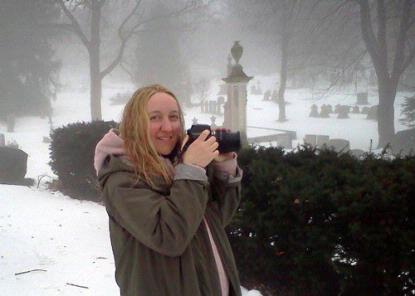In the spring of 1997 I moved to Massachusetts and began graduate studies in studio art, film and photography at Harvard University Extension. A few days after finding an apartment in Cambridge, I began exploring my new “neighbor,” Mount Auburn–a month later I became an employee at the Cemetery.
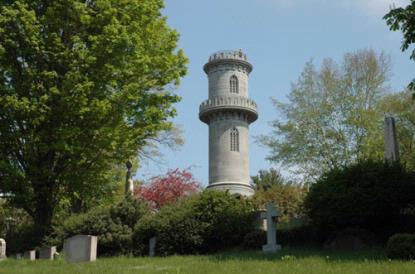
I remember the afternoon of my first visit like it was yesterday–Sunday, May 11th–I had just unloaded my last box from the moving van into my new apartment. I was craving an open space to take a walk and unwind. I set off towards Fresh Pond when my new neighbor came running after me gesturing in the other direction, “go climb Washington tower at Mount Auburn Cemetery and catch a birds-eye view of your new neighborhood!” Two minutes later I was approaching the Egyptian-Revival Gateway at the Cemetery, and about five seconds after that I was smitten (3 weeks later I would be on staff)! But back to that first experience of Mount Auburn in May–although there really aren’t any words sufficient to describe it, I’ll settle for an all-caps version of “WOW”!
Here I was in the midst of an urban oasis–surrounded by the sounds, sights and scents of spring. Throngs of people with binoculars, all my new neighbors with their “eyes to the sky”–scanning for spring migrants in every direction. Hummingbirds, vireos, warblers, orioles in nearly every other tree. Dogwood, cherry, crabapple, redbud–blooming wherever you looked. Tulips, pansies, daffodils, rhodendrons–everywhere in bloom. Rolling topography–ridges, lakes, a pond and vernal pool! Noteworthy figures like, Henry Wadsworth Longfellow, Mary Baker Eddy, Oliver Wendell Holmes, Isabella Stewart Gardner, Edwin Booth and Dorothea Dix. Memorable monuments, statues and structures–Bigelow Chapel, Story Chapel, The Sphinx and Washington Tower. Notable wildlife–turtles, owls, salamanders, coyotes and butterflies.
All of the aforementioned elements coming together to create “…through some subtle alchemy” as Christopher Leahy describes it in Birds & Birding at Mount Auburn Cemetery, “…a slightly enchanted atmosphere that is more than the sum of its parts.”
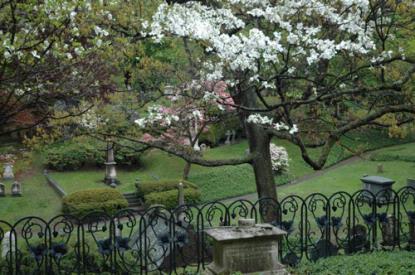
The Mount Auburn landscape is indeed so remarkable, that almost everyone who visits, volunteers or works here is inspired to take photos nearly every moment of the day, every day of the year (SLR, DSLR, point-and-shoot or mobile phone, anyone can get a prize-winning shot, simply by pointing the camera and clicking the shutter in virtually any direction).
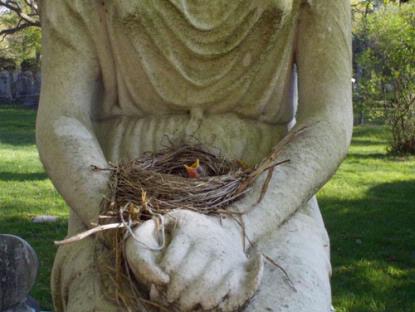
Before the Cemetery was founded in 1831, the topography of landscape was inspiring to visitors, as Ralph Waldo Emerson mentioned in his journal in 1824: “In Cambridge there is some wild land called Sweet Auburn upwards of a mile from the Colleges & yet the students will go in bands over a flat sandy road & in summer evenings the woods are full of them. They are so happy they do not know what to do.”
Since its founding in 1831, Mount Auburn Cemetery has retained its original purpose of being a natural setting for the commemoration of the dead and for the comfort and inspiration of the bereaved and the general public. Its grounds–175 acres of meadows, hills, ponds and woods in Watertown and Cambridge, Massachusetts, just across the Charles River from Boston–offer a place for quiet reflection and the observation of wildlife and nature.
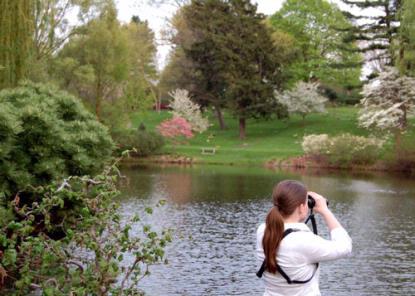
Open 365 days a year–guests from near and far come to study our national heritage by visiting the graves of noted Americans and enjoying the great variety of monuments and memorials. Mount Auburn Cemetery began the “rural” cemetery movement out of which grew America’s public parks. Its beauty and historic associations make it an internationally renowned landscape. Designated a National Historic Landmark, Mount Auburn remains an active, non-sectarian cemetery offering a wide variety of interment and memorialization options.
More than 95,000 individuals are buried and commemorated at Mount Auburn. The Cemetery is a study of art and nature in balance. Throughout its 175 acres are more than 44,000 monuments commemorating the lives and legacies of those buried here. Each monument tells an important story about the individual it celebrates and collectively, these monuments tell the story of 180 years of changing tastes in funerary art, as well as changing ideas about life and death.
Mount Auburn boasts 1,143 taxa (distinct species, subspecies, or varieties) of trees and shrubs that come into bloom at different times and in different seasons. Since its founding in 1831 by the Massachusetts Horticultural Society, the Cemetery has been maintained with the highest regard for horticultural excellence. We recently achieved Level III Accreditation as an arboretum through ArbNet, an international organization promoting the work of arboreta. Among the first arboreta in New England to receive this level of accreditation, and alone among cemeteries nationwide, Mount Auburn is acknowledged for its extraordinary plant collections.
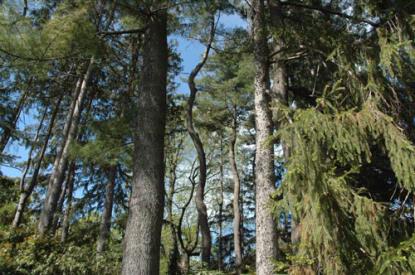
I work for The Friends of Mount Auburn Cemetery–a nonprofit charitable trust promoting the appreciation and preservation of Mount Auburn’s cultural, historic and natural resources. Since its humble beginnings in 1986, the Friends of Mount Auburn now operates a Visitors Center seven days a week, offers over 100 public programs a year and is assisted by a group of over 25 volunteers!
The Friends sponsor walking tours and lectures, publish informational material including Sweet Auburn magazine, and arrange tours for groups. Membership in the Friends is open to all and members receive advance notice and reduced admission for programs, as well as invitations to special “members-only” events. There are over 1,400 members of the Friends of Mount Auburn. Membership contributes to the preservation and maintenance of this beautiful landscape, our significant historical collections and the Friends ongoing schedule of public programs.
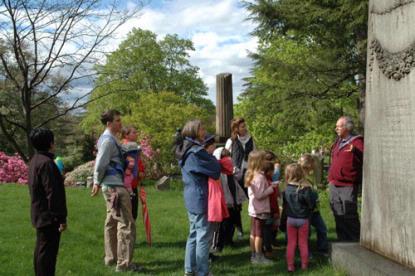
More than fifteen summers, autumns, winters and springs have passed since I first brought my camera to Mount Auburn and yet with each passing day I continue to discover something new. Nothing can replace a first-hand experience of the Cemetery, however if you cannot make it in person today, I invite you to bear witness to Mount Auburn through my lens. Vibrant spring, hazy summer, soul-stirring fall, the grace of winter—which is your favorite season at Mount Auburn? In the coming months I will be a visiting blogger here at the Public Humanist and will share my views of the different ?Seasons? of the Cemetery.
Keep your eye out for me trudging through the snow to get a shot during the winter months, or if the weather is nicer–wandering about on foot or zooming around on a electric gem car.
